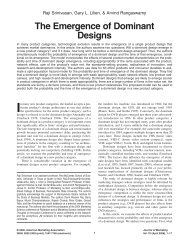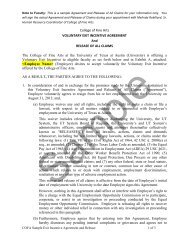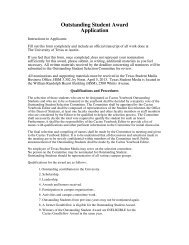Invited Talks: Transition Metal Oxides - University Blog Service - The ...
Invited Talks: Transition Metal Oxides - University Blog Service - The ...
Invited Talks: Transition Metal Oxides - University Blog Service - The ...
You also want an ePaper? Increase the reach of your titles
YUMPU automatically turns print PDFs into web optimized ePapers that Google loves.
<strong>The</strong> John B. Goodenough Symposium in Materials Science & Engineering –<br />
In Honor of His 90 th Birthday<br />
<strong>The</strong> <strong>University</strong> of Texas at Austin, Austin, Texas<br />
October 26-27, 2012<br />
Electrodeposition of Amorphous Silicon Anode for Lithium Ion Batteries<br />
Rigved Epur a , Madhumati Ramanathan b , Faith R. Beck a,c ,<br />
A. Manivannan c and Prashant N. Kumta a,b,d,†<br />
aDepartment of Mechanical Engineering and Materials Science, <strong>University</strong> of Pittsburgh,<br />
Pittsburgh, PA 15261, USA<br />
bDepartment of Bioengineering, <strong>University</strong> of Pittsburgh, Pittsburgh, PA 15261, USA<br />
cUS Department of Energy, National Energy Technology Laboratory, Morgantown, WV 26507, USA<br />
dDepartment of Chemical and Petroleum Engineering, <strong>University</strong> of Pittsburgh, Pittsburgh, PA 15261,<br />
USA<br />
Email: pkumta@pitt.edu, manivana@netl.doe.gov<br />
Amorphous silicon has been successfully electrodeposited on copper using a SiCl4 based organic<br />
electrolyte under galvanostatic conditions. <strong>The</strong> electrodeposited silicon films were characterized for their<br />
composition, morphology and structural characteristics using glancing angle x-ray diffraction (GAXRD),<br />
scanning electron microscopy (SEM), and Raman spectroscopy. GAXRD and Raman analyses clearly<br />
confirm the amorphous state of the deposited silicon film. <strong>The</strong> deposited films were tested for possible<br />
application as anodes for Li-ion battery. <strong>The</strong> results indicate that this binder less amorphous silicon anode<br />
exhibits a reversible capacity of ~1300 mAh g -1 with a columbic efficiency of > 99.5% up to 100 cycles.<br />
Impedance measurements at the end of each charge cycle show a non-variable charge transfer resistance<br />
which contributes to the excellent cyclability over 100 cycles observed for the films. This approach of<br />
developing thin amorphous silicon films directly on copper eliminates the use of binders and conducting<br />
additives, rendering the process simple, facile and easily amenable for large scale manufacturing.
















